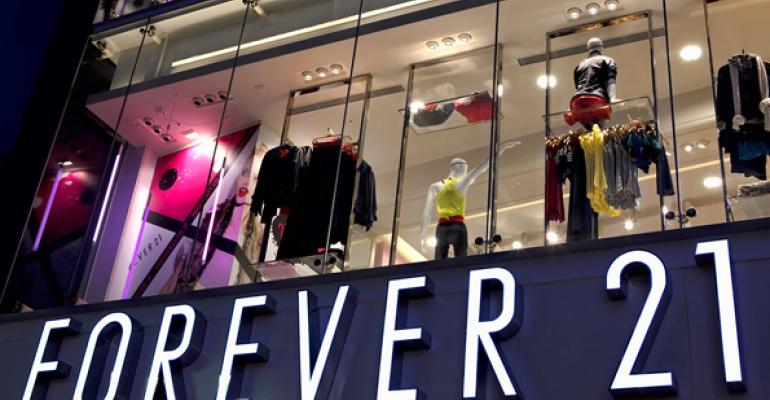Apparel retailer Forever 21 is an important tenant, occupying millions of square feet in regional malls, lifestyle properties and outlet centers. The chain is the fifth largest specialty retailer in the nation, and recent speculation about the poor performance of its bigger stores has the industry buzzing about the competitive pressures facing Forever 21, and how they might affect its future real estate strategy.
“Forever 21 was an opportunist,” says Michael Lushing, principal with Los Angeles-based Lushing Retail Advisors. “When they were presented with a bunch of big, empty boxes, they said yes to a lot of them.
They got stuck with a ton of GLA they needed to fill and, at the same time, they got inundated with competition from overseas. There are a lot of folks challenging Forever 21 right now, and Forever 21’s big stores are too much work for their customers. If someone can find a nice variety in a smaller space, they’re going to shop there.”
No clear strategy
Forever 21 is a private company, so it’s a challenge to get an accurate picture of the retailer’s financial health. The chain didn’t respond to NREI’s request for an interview, but recent reports indicate that sales will likely reach $4.5 billion this year, a 15 percent increase from 2013.
The retailer has announced that it wants to become an $8 billion company by 2017, and to open 600 stores in the next three years. Recently, Forever 21 launched Red21, a smaller format store with even lower price points than its flagship concept.
Currently, Forever 21 operates 600 stores worldwide, primarily in regional malls. The average store is 38,000 sq. ft., and the largest is approximately 162,000 sq. ft. The original Fashion 21 store, opened in 1984, is only 900 sq. ft.
“I’m not sure Forever 21 really had a real estate strategy in the past,” says one industry expert who has significant experience with the retailer. “They’ve approached real estate in an old-school way—going with their gut rather than hard data. For example, in the past they’ve been known to take an old movie theater because they liked the location.”
Although there’s no sign Forever 21 plans to close its larger stores or pull back on its expansion plans, many experts question the chain’s decision to operate such large stores, which demand a large assortment of merchandise. Over the years, the company has added a number of new departments, including contemporary, plus sizes, men’s, children’s, lingerie and shoes.
“Forever 21 has lost its focus on core customers,” says Andres Mendoza-Pena, a principal at global management firm A.T. Kearney. “They expanded the size of their stores, but they did so without a customer-centric approach—finding new merchandise to fill the stores rather than filling the stores with what the core customers wants.”
At the same time, competition in the fast fashion sector is heating up, and now includes H&M, Zara, Primark and Uniqlo USA.
“Well-established players like Forever 21 are starting to struggle, and it’s hard to tell who is going to emerge as the winner,” says Mendoza-Pena.
The dangers of being opportunistic
Today, Forever 21 is one of the largest tenants at many malls. For example, the chain accounts for 5.5 percent of Taubman Centers’ GLA, according to the REIT’s supplemental filings.
“A lot of retailers get caught up in their own momentum,” says Robin Lewis, CEO of The Robin Report, a retail consultancy. “I think that’s what happened with Forever 21—they’ve just grown too fast, and now they’re having a hard time figuring out what to do with all the space.”
The chain’s earlier stores ranged from 10,000 to 12,000 sq. ft. In the early 2000s, it rolled out XXI, a larger format store that filled 24,000 sq. ft., and began to take vacant junior anchor spaces. In 2008, the company bought 15 dark Mervyns stores, with an average box size of 80,000 sq. ft.
The Mervyns’ space was heavily concentrated on the West Coast and in Southwestern U.S., with seven of the stores located in California. “A lot of retailers feel like they can’t lose in California, and they take risks there they wouldn’t in other markets,” says Paul Morgan, managing director and senior equity analyst at boutique investment bank MLV & Co.
The Mervyns stores were at least five times bigger than Forever 21’s existing stores, and that raised a lot of eyebrows in the industry, according to Morgan. “People wondered about the long-term success in that kind of space.”
Morgan points out that Forever 21’s private status means there’s not a lot of visibility into how well the company is performing, but says there is a moral to the story.
“Space becomes available when other retailers are going through distress, and growing retailers often try to capitalize on that. If they take it just because it’s available, that could be a mistake because they often end up shifting their strategy to make their concept fit. Forever 21 might be an example of a retailer that overextended itself by trying to be opportunistic.”

